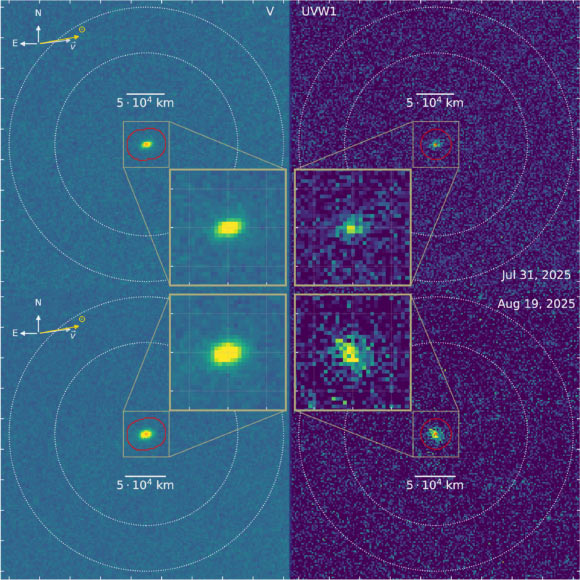Using the Ultraviolet/Optical Telescope aboard NASA’s Neil Gehrels Swift Observatory, astronomers have detected hydroxyl (OH) gas — a chemical fingerprint of water — from the interstellar object 3I/ATLAS.

Stacked images of the interstellar comet 3I/ATLAS acquired with the Ultraviolet/Optical Telescope aboard NASA’s Neil Gehrels Swift Observatory: the first were obtained on July 31 and August 1, 2025 (visit 1, top half of figure) and the second on August 19, 2025 (visit 2, bottom half of figure). Image credit: Xing et al., doi: 10.3847/2041-8213/ae08ab.
The discovery of the third interstellar object, 3I/ATLAS, on July 1, 2025 initiated a broad characterization campaign across the globe.
Following the lessons learned from the prior interstellar objects 1I/‘Oumuamua and 2I/Borisov, observing campaigns were initiated to rapidly capture its initial brightness, morphology, light-curves, color, and optical and near-infrared spectrum.
Given the apparent brightness and early extension of the coma, the production of gas was assumed and searched for, but not found.
Characterizing the early activity of interstellar objects is essential for understanding their chemical and physical evolution during solar approach, as it possibly represents the first time they have been significantly heated in their very long dynamic lifetimes.
“Detecting water is a major breakthrough for understanding how interstellar comets evolve,” said Auburn University astronomer Dennis Bodewits and colleagues.
“In solar-system comets, water is the yardstick by which scientists measure their overall activity and track how sunlight drives the release of other gases.”
“It’s the chemical benchmark that anchors every comparison of volatile ices in a comet’s nucleus.”
“Finding the same signal in an interstellar object means that, for the first time, we can begin to place 3I/ATLAS on the same scale used to study native solar-system comets — a step toward comparing the chemistry of planetary systems across our Milky Way Galaxy.”
“What makes 3I/ATLAS remarkable is where this water activity occurs.”
Swift detected hydroxyl when the comet was nearly three times farther from the Sun than Earth — well beyond the region where water ice on a comet’s surface can easily sublimate — and measured a water-loss rate of about 40 kg per second. At those distances, most solar-system comets remain quiet.
The strong ultraviolet signal from 3I/ATLAS suggests that something else is at work: perhaps sunlight is heating small icy grains released from the nucleus, allowing them to vaporize and feed the surrounding cloud of gas.
Such extended sources of water have been seen only in a handful of distant comets and point to complex, layered ices that preserve clues to how these objects formed.
Each interstellar comet discovered so far has revealed a different side of planetary chemistry beyond our Sun.
Together, they demonstrate that the building blocks of comets — and the volatile ices that shape them — can vary dramatically from one star system to another.
These differences hint at how diverse planet-forming environments can be, and how processes like temperature, radiation, and composition sculpt the materials that ultimately seed planets and, potentially, life.
Catching that whisper of ultraviolet light from 3I/ATLAS was a technical triumph in itself.
Swift carries a modest 30-cm telescope, but in orbit above Earth’s atmosphere it can see ultraviolet wavelengths that are almost completely absorbed before reaching the ground.
Free from the sky’s glare and air’s interference, Swift’s Ultraviolet/Optical Telescope achieves the sensitivity of a 4-m-class ground telescope for these wavelengths
Its rapid-targeting capability allowed the astronomers to observe the comet within weeks of discovery — long before it grew too faint or too close to the Sun to study from space.
“When we detect water — or even its faint ultraviolet echo, OH — from an interstellar comet, we’re reading a note from another planetary system,” Professor Bodewits said.
“It tells us that the ingredients for life’s chemistry are not unique to our own.”
“Every interstellar comet so far has been a surprise,” added Dr. Zexi Xing, a postdoctoral researcher at Auburn University.
“‘Oumuamua was dry, Borisov was rich in carbon monoxide, and now ATLAS is giving up water at a distance where we didn’t expect it.”
“Each one is rewriting what we thought we knew about how planets and comets form around stars.”
A paper describing the findings was published September 30 in the Astrophysical Journal Letters.
_____
Zexi Xing et al. 2025. Water Production Rates of the Interstellar Object 3I/ATLAS. ApJL 991, L50; doi: 10.3847/2041-8213/ae08ab







